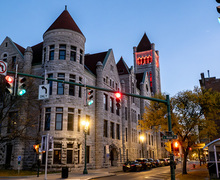Average SU salaries rank comparably to peer institutions
The average compensation of Syracuse University faculty for the 2010-11 academic year ranks 35th out of 67 in a group with comparable institutions, according to the annual Committee Z Report released March 3.
SU slipped four spots in the rankings from 2009-10. The average compensation of full-time faculty this year was $117,800, a 0.7 percent increase over the prior year. In 2009-10, the average compensation for full-time faculty increased 2.8 percent from $113,800 to $117,000, according to the 2009-10 Committee Z Report.
Compensation includes the amount of salary and value of benefits, such as retirement and medical and dental insurance, among others, for faculty, said Pat Cihon, an associate professor of law and public policy and president of SU’s chapter of the American Association of University Professors, which releases the report each year.
Cornell University and the University of Rochester were added to the group of comparable institutions this year because the schools are in the same region, he said, and SU is often compared with them.
‘Regardless of which comparator group is used, it is clear that Syracuse University faculty are losing ground in comparison to their colleagues at other institutions,’ Cihon said in the cover letter to the report.
The average salary for 329 full-time professors at SU for 2010-11 is $115,321. In the previous academic year, the average salary of full-time SU professors was $112,452.
The 310 full-time associate professors at SU for 2010-11 have an average salary of $83,760, and the 279 full-time assistant professors have an average salary of $70,765. The mean salary for full-time associate professors for 2009-10 was $81,991, while the average salary for full-time assistant professors was $69,081.
SU’s position in the group of 67 schools stayed consistent with past years, as the university is always in the middle or below the middle in the group, Cihon said.
‘In the bigger picture, we’re not improving,’ he said. ‘If we’re lucky, we’re holding steady, but in most cases, we’re relatively losing ground.’
Cihon said the university made permanent changes to employee benefits last year. SU increased the employee contribution for health insurance and reduced the contribution to the faculty’s retirement accounts by 1 percent, he said. The changes offset the raise in compensation the faculty received for 2009-10, Cihon said.
Vice Chancellor and Provost Eric Spina said the changes made last year reduced a number of benefits but also added some. He said he expects some members of the faculty to use the new benefits, although others may not.
‘I accept that there are some people among the faculty who have a lower salary increment and don’t take advantage of the new benefits and therefore have a net very close to zero or net negative impact on their total compensation,’ Spina said.
Spina said the university’s goal is to achieve at least a middle ranking among the institutions it is compared to in the report. He plans to appoint a task force of faculty members and a couple of administrators who will look closely at the salary data to make sure SU is using the right peer comparisons, among other purposes, he said.
‘The chancellor has stated very clearly to her administrative cabinet, which includes the deans but also the Senate Budget Committee, that increasing faculty compensation, because it’s a national market, is the highest priority over the next several years,’ Spina said.
Jeff Stonecash, a political science professor, was a member of the University Senate Budget Committee for the past three years and said even if the administration says it is going to do something about the salary problem, it can’t be done.
Stonecash said although professors are paid well compared to average Americans, the 1 percent reduction in retirement will cost faculty a lot. SU’s faculty salaries are lower than other schools’, which hurts the university’s ability to attract and retain faculty, he said.
The raises some faculty have received during the past three years do not equal the cost of living in Syracuse, said Cihon, president of SU’s chapter of the American Association of University Professors. The increase in the local cost of living for the past three years was 8.3 percent, he said. During those three years, 59 percent — or 421 faculty members — didn’t receive raises equal to the rise in the cost of living, Cihon said.
In the 2009-10 report, SU was compared to other institutions that were adjusted for the differences in the cost of living, which increased the university’s ranking from 31st to 24th in the group of 67 based on compensation. The adjustment didn’t consider state and local taxes or real estate taxes, but it instead accounted for differences in the costs of goods and services.
Adjusting for the cost of living allows SU to look better in the salary report, Cihon said.
Cihon also said in the report that he has continued to notice the increase in ‘non-tenure-track’ positions. There are 103 non-tenured faculty at SU for 2010-11, an increase from 87 in 2004-05.
Spina, vice chancellor and provost, said the increase in non-tenure-track positions can help students. At one time, it was thought only pure academic faculty were welcome in the classroom, he said.
‘But now I think the faculty and administrators recognize that mixing in some number of professors of practice really helps us make the students’ education better,’ Spina said, ‘and helps to better prepare those students for the world.’
Published on March 8, 2011 at 12:00 pm
Contact Jon: jdharr04@syr.edu





